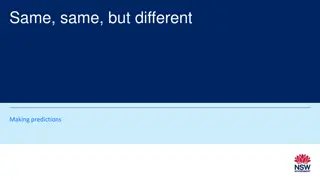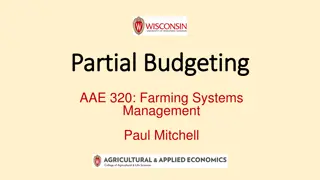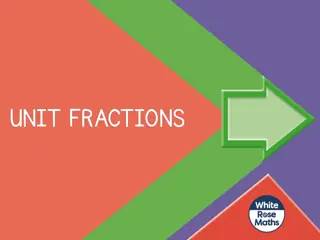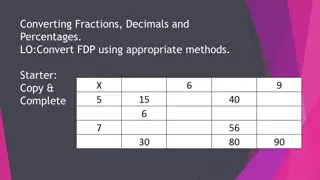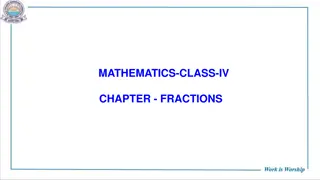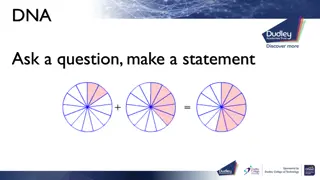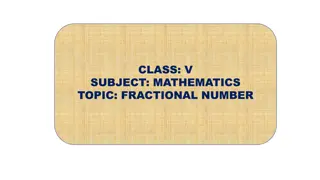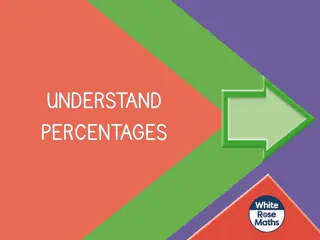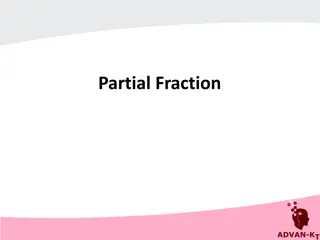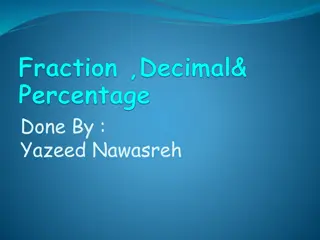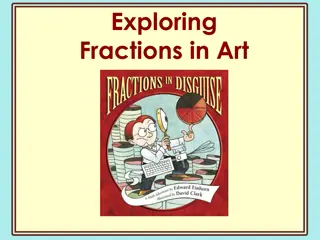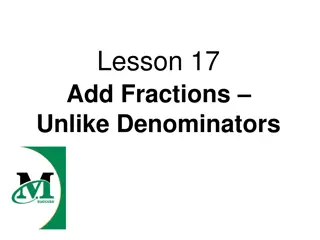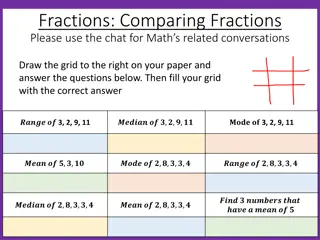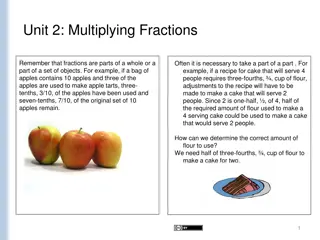
Partial Fractions with Repeated Factors and Improper Fractions
Learn how to decompose algebraic expressions into partial fractions with repeated factors or when dealing with improper fractions. Practice writing mixed numbers and equating numerators to simplify expressions. Understand how to handle top-heavy fractions and identify improper fractions based on polynomial degrees.
Download Presentation

Please find below an Image/Link to download the presentation.
The content on the website is provided AS IS for your information and personal use only. It may not be sold, licensed, or shared on other websites without obtaining consent from the author. If you encounter any issues during the download, it is possible that the publisher has removed the file from their server.
You are allowed to download the files provided on this website for personal or commercial use, subject to the condition that they are used lawfully. All files are the property of their respective owners.
The content on the website is provided AS IS for your information and personal use only. It may not be sold, licensed, or shared on other websites without obtaining consent from the author.
E N D
Presentation Transcript
Partial fractions Repeated factors
Algebra: Partial fractions KUS objectives BAT put expressions into partial fractions where the denominator has repeated factors or the original fraction is improper (top heavy) Starter: work out / write as mixed numbers 75 30 24 7+31 6 200 3 4 Check answers with a calculator
WB7a write a) 4?1 ? ? ? 12 in partial fractions = (? 1)+ ? 12 Make the denominators the same 4? 1 ? 12= ?(? 1) (? 1)(? 1)+ ? ? 12 Now equate the numerators 4? 1 = ?(? 1) + ? Let ? = 1 then 3 = (0) + ?) gives ? =3 Let ? = 2 then 7 = ?(1) + ? gives ? = 4 4? 1 ? 12= 4 3 (? 1)+ ? 12
WB7b write b) 11?2+14?+5 ? ? ? ?+12(2?+1) in partial fractions = (? + 1)+ ? + 12+ 2? + 1 Make the denominators the same 11?2+ 14? + 5 ? + 12(2? + 1)=?(? + 1)(2? + 1) ? ? + 12 ? + 12(2? + 1) ?(2? + 1) ? + 12(2? + 1)+ ? + 12(2? + 1)+ Now equate the numerators 11?2+ 14? + 5 = ?(? + 1)(2? + 1)+ ?(2? + 1)+ ? ? + 12 Let ? = 1 then 11 14 + 5 = 0 + ? 1 + (0) gives ? =-2 Let ? = 1 then 11 4 14 1 4 2 2+ 5 = 0 + 0 + ? gives ? = 3 gives ? = 4 Let ? = 0 then 5 = ? 1 + ? 1 + ? 1 11?2+ 14? + 5 ? + 12(2? + 1)= 4 2 3 (? + 1) ? + 12+ 2? + 1
3?2+18 (1 2?) 2+?2 in partial fractions WB7c write c) Include a repeated factor term when usig partial fractions 3?2+ 18 (1 2?) 2 + ?2= ? ? ? (1 2?)+ 2 + ?+ 2 + ?2 Now equate the numerators 3?2+ 18 = ? 2 + ?2+ ?(1 2?)(2 + ?)+ ?(1 2?) Let ? = 2 then 12 + 18 = 0 + 0 + ?(5) gives C= 6 Let ? =1 then 3 25 4 2 4+ 18 = ? + 0 + 0 gives ? = 3 gives ? = 0 Let ? = 0 then 18 = ? 4 + ? 2 + ? 1 3?2+ 18 (1 2?) 2 + ?2= 3 6 (1 2?)+ 2 + ?2
Partial fractions Top-Heavy fractions
Dealing with Improper Fractions The degree of a polynomial is the highest power, e.g. a quadratic has degree 2. An algebraic fraction is improper if the degree of the numerator is at least the degree of the denominator.
WB8 (method 1) write 3?23?2 (? 1)(? 2) in partial fractions Remember, Algebraically an improper fraction is one where the degree (power) of the numerator is equal to or exceeds that of the denominator 3?2 3? 2 (? 1)(? 2)= 3?2 3? 2 ?2 3? + 2 3 Divide the numerator by the denominator to find the whole part ?2 3? + 2 3?2 3? 2 3?2 9? 6 6? 8 3?2 3? 2 (? 1)(? 2)= 3 + 6? 8 (? 1)(? 2)
3?23?2 (? 1)(? 2)= 3 + 6? 8 (? 1)(? 2) WB8 (continued method 1) Remember, Algebraically an improper fraction is one where the degree (power) of the numerator is equal to or exceeds that of the denominator 6? 8 ? ? (? 1)(? 2)= ? 1+ ? 2 Now equate the numerators 6? 8 = ?(? 2) + ?(? 1) Let ? = 2 gives B = 4 Let ? = 1 gives ? = 2 3?2 3? 2 (? 1)(? 2)= 3 + 2 4 ? 1+ ? 2
WB8 (Alternative method 2) write 3?23?2 (? 1)(? 2) in partial fractions Write as whole part and partial fractoons 3?2 3? 2 (? 1)(? 2) = ? + ? ? ? 1+ ? 2 Now equate the numerators 3?2 3? 2 = ? ? 1 ? 2 + ? ? 2 + ?(? 1) Let ? = 1 then 3 3 2 = 0 + ? 1 + (0) gives ? = 2 Let ? = 2 then 12 6 2 = 0 + 0 + ?(1) gives ? = 4 Let ? = 0 then 2 = ? 2 + ? 2 + ?( 1) gives ? = 3 3?2 3? 2 (? 1)(? 2) = 3 + 2 4 ? 1+ ? 2
WB9 write 9?2+20?10 (?+2)(3? 1) in partial fractions Write as whole part and partial fractoons 9?2+ 20? 10 (? + 2)(3? 1)= ? + ? ? ? + 2+ 3? 1 Now equate the numerators 9?2+ 20? 10 = ? ? + 2 3? 1 + ? 3? 1 + ?(? + 2) Let ? = 2 then 36 40 10 = 0 + ? 7 + (0) gives ? =2 Let ? =1 then 9 9+20 3 10 = 0 + 0 + ?(7 gives ? = 1 3 3) Let ? = 0 then 10 = ? 2 + ? 1 + ?(2) gives ? = 3 9?2+ 20? 10 (? + 2)(3? 1)= 3 + 2 1 ? + 2 3? 1
KUS objectives BAT put expressions into partial fractions where the denominator has repeated factors or the original fraction is improper (top heavy) self-assess One thing learned is One thing to improve is


